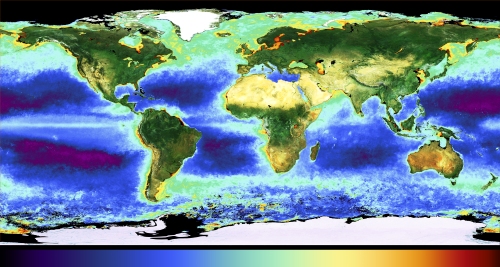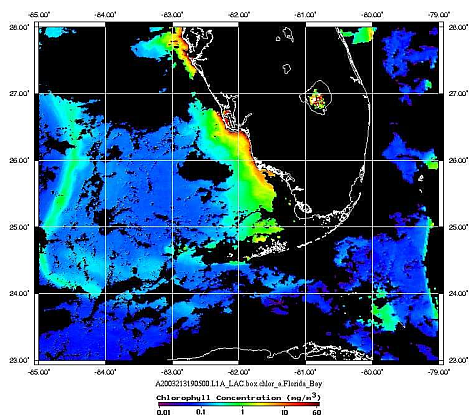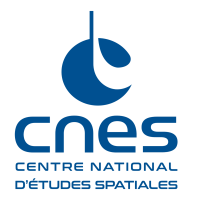Optical radiometers
What do they measure?
- Chlorophylle content
- " Content of organic and mineral matter
Principles of measurement
Sensors, called "optic" are, by definition, sensitive to radiance in the "visible" part of the electromagnetic spectrum (those that the human eye is capable of picking-up) and the near infrared (wavelengths from 0.4 µm to 2µm).
These instruments measure solar radiance reflected by the surface. The quantity of reflected energy depends on the optical characteristics of the surface: for example, an absorbent surface reflects less light than ice. Moreover, depending on the surface, certain wavelengths can be absorbed more than others and give a colour to the reflected light.

World map showing the concentration of chlorophyll (Meris instrument) (Credits ESA)
The colour of the ocean is determined by the interactions between incident solar light and substances in the water. The principle substances at sea are the photosynthetic organisms or phytoplankton. Phytoplankton contain chlorophyll which absorbs the light in the blue and red wavelengths and transmits the green, just like the leaves on trees and most of the Earth's vegetation. Near the shores and often deposited by rivers, we can find suspended sediments than can be of organic or mineral, natural or human origin.
Optical sensors used for the ocean colour are wide swath imagers (from 500 to 2500 km wide) with a high resolution (1 km).
These sensors have limitations: they cannot take measurements at night (of course, because there is no reflected sun light!), nor can they take measurements when there are clouds, nor when the sensor is blinded by the Sun. This is why, just as for sea surface temperature data, chlorophyll restitution techniques must implement cloud filters and rely on temporal compositions that take several days of data into account in order to obtain complete data maps showing "no gaps".


Two images of chlorophyll concentration provided by SeaWifs sensors (top) and Modis sensors (bottom) (Credits NASA)
Today's operational instruments
- Modis on Aqua (Nasa, USA)
- Viirs on Suomi NPP (Nasa, USA)
- Olci on Sentinel-3 A & B (EU/Esa)

